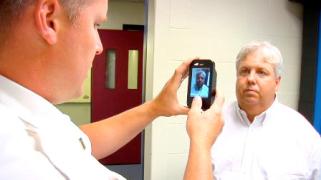“The technology is a game-changer,” McDonald said. “It’s going to enable officers to really get a handle on who the bad guys are, and make it more difficult for these bad guys to hide from us.”
*****
I really like technologies like this, because they piggy back on already available platforms that everyone is familiar with. Plus this is just neat. To be able to use your iPhone to capture electronic fingerprints, iris scans and photographs, and then send them into a massive database to tell if you have a criminal or not, is pretty damn cool.
This could also have application in the war. Biometrics were used in cities like Falujah in Iraq, to keep track of everyone coming in and out of check points. If you can put together a database of everyone’s identity in a population center, and you have iris/photo/finger print identification for each person, you can track people way better. It could also help out a country in determining the status of their population, and truly identifying people who are citizens so they could award them the services they deserve. We should be using these technologies more, if we want to separate the bad guys from the good guys.
Plus contractors and soldiers have access to iPhones, and many carry them.(I carry one on contracts) Or these smart phones could be purchased off the shelf for military units, and distributed that way. The phones come equipped with all the computing power and mobile apps available on the internet. Apple makes a great product, and they have fantastic support for that product. Devices like the MORIS just slip over the thing, and give it this capability. That is far better than re-inventing the wheel, and paying for that re-invention to get a product that will probably be less capable than what is currently available. –Matt
——————————————————————
‘IPhone on Steroids’ Gives Law Enforcement a Biometric Boost
Jun 25, 2010
By Russell Nichols
Plymouth County, Mass., Sheriff Joseph McDonald calls the county’s latest crime-fighting tool “an iPhone on steroids.”
A fitting description for the device, which he said enhances and strengthens the ability of law enforcement officers to identify suspects and retrieve their criminal records in seconds by capturing biometric data.
“The technology is a game-changer,” McDonald said. “It’s going to enable officers to really get a handle on who the bad guys are, and make it more difficult for these bad guys to hide from us.”
This month, Plymouth County became the first in the country to deploy the Mobile and Wireless Multi-Modal Biometric Offender Recognition and Information System (MORIS). The system is part of a national network, designed to help law enforcement agencies keep track of sex offenders, gang members, inmates and illegal aliens, said Sean Mullin, president of Plymouth-based Biometric Intelligence and Identification Technologies (BI2 Technologies), which developed MORIS in partnership with Apple.
Paid for by a $200,000 federal grant funneled through the Massachusetts Sheriffs’ Association, the technology is a sleeve that fits over an iPhone and captures electronic fingerprints, iris scans and photographs. The biometric data then gets sent to an encrypted and secure cloud-like database.
In the last couple of years, Mullin said, technology advances and the buildup of data have made biometrics a wave of the future of law enforcement.
“The demand for it has been unbelievable,” Mullin said. “It provides officers with the tool they need while out in the community to be able to positively identify who they have in front of them and understand their criminal background.”
The basic device costs $1,500, Mullin said, but agencies would need to fork over $3,000 a piece for the “pumped-up version.” In Massachusetts, the award allows for the deployment of MORIS in all of the state’s 14 sheriffs’ departments and up to 28 local police departments. And while the use of biometrics to obtain information goes back decades, McDonald said, the big change is how fast officers can send and retrieve that data on the street.
But according to the American Civil Liberties Union (ACLU) of Massachusetts, the use of these technologies raises a few civil liberties questions: For example, who will be subject to being photographed and entered into a database? (Law enforcement officials say only suspects will be photographed.)
To get answers, the ACLU submitted public records requests to the Brockton Police Department, the Massachusetts Sheriffs’ Association and the Plymouth County Sheriff. The system has never been deployed by local police departments, so the ACLU wants to find out how its use may impact individual rights, wrote ACLU of Massachusetts staff attorney Laura Rótolo in a letter to the three agencies.
“This is an experiment using the people of Brockton as guinea pigs,” Rótolo said in a release. “This request for records is the first step toward ensuring that scarce resources are used wisely, and that civil liberties are protected.”
Story here.

16And he causeth all, both small and great, rich and poor, free and bond, to receive a mark in their right hand, or in their foreheads:
17And that no man might buy or sell, save he that had the mark, or the name of the beast, or the number of his name.
18Here is wisdom. Let him that hath understanding count the number of the beast: for it is the number of a man; and his number is Six hundred threescore and six.
Involuntary collection of biometric data is like involuntary collection of DNA. An uncooperative subject will have to be arrested and forced to comply, which may not make for pretty pictures when the subject is released.
Comment by Cannoneer No. 4 — Tuesday, June 29, 2010 @ 9:24 AM